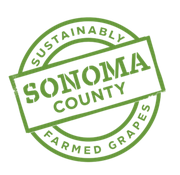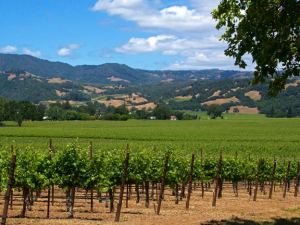Readers of Power Tasting don’t need to be told that Sonoma County in northern California is a mighty nice place to visit. Its size and vineyard diversity make it one of the best places to sample many of California’s finest wines. However, Sonoma’s commitment to sustainability in its vineyards and wineries does offer a different reason to visit there.
 The symbol found on bottles of sustainably made Sonoma wines
The symbol found on bottles of sustainably made Sonoma wines
A lot of this is a matter of survival for the winemaking industry in the county. It isn’t newsworthy that northern California suffers from many multi-year droughts. In fact, they are in one right now. If the growers did not pay attention to water and land conservation, it would not be long before the quality of the wines would suffer. And that would be the most positive result. The worst case would be the inability to grow wine grapes at all.
The trade organization, Sonoma County Winegrowers, is justly proud that 99% of the vineyard acreage, more than 60,000 acres, in the county are independently certified to be sustainable. The group established a goal in 2014 to make Sonoma County the premier sustainable winegrowing region in the world. Their interest was not pure environmentalism. While there are some massive properties there, the majority of vineyards are family owned and operated smallholdings. Accordingly, they are not only preserving a crop but also a way of life.
 Look carefully and you can see the hoses dripping water onto the vines. Photo courtesy of Sonoma County Tourism.
Look carefully and you can see the hoses dripping water onto the vines. Photo courtesy of Sonoma County Tourism.
How does all this make Sonoma County even more of a place to visit? It’s difficult to watch water not evaporate or land not get parched. We believe that every wine tasting visitor spends at least a little time looking at and admiring row after row of vines. Now, when you go to Sonoma County, look a little more closely. Do you see hoses running through the vineyard for drip irrigation? Or maybe nothing to water the vines for those growers who prefer dry farming? In the heat of the middle of the summer, are the canopies over the vines thick with leaves to inhibit evaporation?
Most of this doesn’t matter to your main purpose: trying wines. But it should matter than it’s a concern for the grower and the vintner. So when you get to the bar, maybe ask a few questions about what that winery is doing in the sustainability effort. You may stir up a bit of controversy. For example, the dry farmers think the irrigators are irresponsible, while the irrigators think the dry farmers are nuts.
So when we visit, let’s tell them that we appreciate what the Sonoma growers are doing to preserve both winemaking and the local community over the long haul. They are the ones making the investment and we are reaping the benefits. Letting the growers know that you’re grateful may elicit just the kind of personal interaction that makes traveling through Wine Country so rewarding.